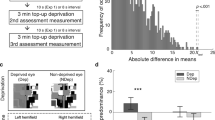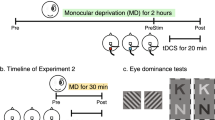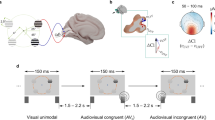Abstract
Preventing visual input to one eye (monocular deprivation) in early postnatal development reduces cortical responses to stimulation of the deprived eye, with a significant loss of thalamocortical connections. These effects are reversible by opening the deprived eye and closing the previously open eye (reverse occlusion). We show that intracortical blockade of tissue plasminogen activator or plasmin selectively prevents recovery of cortical function and thalamic neuron size during reverse occlusion, without affecting the monocular deprivation response. Therefore, a proteolytic cascade consisting of plasmin generated by tissue plasminogen activator may selectively mediate reverse-occlusion-induced cortical plasticity, perhaps via structural remodeling of axons.
This is a preview of subscription content, access via your institution
Access options
Subscribe to this journal
Receive 12 print issues and online access
$209.00 per year
only $17.42 per issue
Buy this article
- Purchase on Springer Link
- Instant access to full article PDF
Prices may be subject to local taxes which are calculated during checkout





Similar content being viewed by others
References
Shatz, C.J. Impulse activity and the patterning of connections during CNS development. Neuron 5, 745–756 (1990)
LeVay, S., Stryker, M.P. & Shatz, C.J. Ocular dominance columns and their development in layer IV of the cat's visual cortex: a quantitative study. J. Comp. Neurol. 179, 223–244 (1978)
Shatz, C.J. & Stryker, M.P. Ocular dominance in layer IV of the cat's visual cortex and the effects of monocular deprivation. J.Physiol. (Lond.) 281, 267–283 (1978)
Wiesel, T.N. & Hubel, D.H. Single-cell responses in striate cortex of kittens deprived of vision in one eye. J. Neurophysiol. 26, 1003–1017 (1963)
Movshon, A. & Dürsteler, M.R. Effects of brief periods of unilateral eye closure on the kitten's visual cortex. J. Neurophysiol. 40, 1255–1265 (1977)
Guillery, R.W. Binocular competition in the control of geniculate cell growth. J. Comp. Neurol. 144, 117–130 (1972)
Antonini, A. & Stryker, M.P. Plasticity of geniculocortical afferents following brief or prolonged monocular occlusion in the cat. J. Comp. Neurol. 369, 64–82 (1996)
Blakemore, C. & Van Sluyters, R.C. Reversal of the physiological effects of monocular deprivation in kittens: further evidence for a sensitive period. J. Physiol.( Lond.) 237, 195– 216 (1974)
Movshon, J.A. Reversal of the physiological effects of monocular deprivation in the kitten's visual cortex. J.Physiol. (Lond.) 261, 125– 174 (1976)
Dürsteler, M.R., Garey, L.J. & Movshon, J.A. Reversal of the morphological effects of monocular deprivation in the kitten's lateral geniculate nucleus. J. Physiol. (Lond.) 261, 189–210 (1976)
Swindale, N.V., Vital-Durand, F. & Blakemore, C. Recovery from monocular deprivation in the monkey. Proc. R. Soc. Lond. 213, 435–450 (1981)
Bear, M.F., Kleinschmidt, A., Gu, Q. & Singer, W. Disruption of experience-dependent synaptic modification in striate cortex by infusion of NMDA receptor antagonist . J. Neurosci. 10, 909– 925 (1990)
Gu, Q., Bear, M.F. & Singer, W. Blockade of NMDA-receptors prevents ocularity changes in kitten visual cortex after reversed monocular deprivation. Dev. Brain Res. 47, 281–288 (1989)
Kasamatsu, T. & Pettigrew, J.D. Depletion of brain catecholamines: failure of ocular dominance shift after monocular occlusion in kittens. Science 267, 1658–1662 (1976)
Bear, M.F. & Singer, W. Modulation of visual cortical plasticity by acetylcholine and noradrenaline. Nature 320, 172–176 (1986)
Bonhoeffer, T. Neurotrophins and activity-dependent development of the neocortex. Curr. Opin. Neurobiol. 6, 119–126 (1996)
Staubli, U., Larson, J., Thibault, O., Baudry, M. & Lynch, G. Chronic administration of a thiol-proteinase inhibitor blocks long-term potentiation of synaptic responses. Brain Res. 444, 153–158 (1988)
Denny, J.B., Polan-Curtain, J., Ghuman, A., Wayner, M.J. & Armstrong, D.L., Calpain inhibitors block long-term potentiation. Brain Res. 534, 317–320 (1990)
Qian, Z., Gilbert, M.E., Colicos, M.A., Kandel, E.R. & Kuhl, D. Tissue-plasminogen activator is induced as an immediate-early gene during seizure, kindling and long-term potentiation. Nature 361, 453–457 (1993)
Huang, Y.-Y. et al. Mice lacking the gene encoding tissue-type plasminogen activator show a selective interference with late-phase long-term potentiation in both Schaffer collateral and mossy fiber pathways. Proc. Natl. Acad. Sci. USA 93, 8699–8704 (1996)
Gualandris, A., Jones, T.E., Strickland, S. & Tsirka, S.E. Membrane depolarization induces calcium-dependent secretion of tissue plasminogen activator. J. Neurosci. 16, 2220– 2225 (1996)
Krystosek, A. & Seeds, N.W. Plasminogen activator release at the neuronal growth cone. Science 213, 1532 –1534 (1981)
Pittman, R.N. & DiBenedetto, A.J. PC12 cells overexpressing tissue plasminogen activator regenerate neurites to a greater extent and migrate faster than control cells in complex extracellular matrix. J. Neurochem. 64, 566–575 (1995)
McGuire, P.G. & Seeds, N.W. Degradation of underlying extracellular matrix by sensory neurons during neurite outgrowth. Neuron 4, 633–642 (1990)
Chen, Z.-L. & Strickland, S. Neuronal death in the hippocampus is promoted by plasmin-catalyzed degradation of laminin. Cell 91, 917–925 (1997)
Hamakubo,T., Kannagi, R., Murachi, T. & Matus, A. Distribution of calpains I and II in rat brain. J. Neurosci. 6, 3103 –3111 (1986)
Nakajima, K., Tsuzaki, N., Nagata, K., Takemoto, N. & Kohsaka, S. Production and secretion of plasminogen in cultured rat brain microglia. FEBS Lett. 308, 179– 182 (1992)
Stürzebecher, J., Neumann, U., Kohnert, U., Kresse, G.-B. & Fischer, S. Mapping of the catalytic site of CHO-t-PA and the t-PA variant BM 06.022 by synthetic inhibitors and substrates. Protein Science 1, 1007–1013 (1992)
Heussen, C. & Dowdle, E.B. Electrophoretic analysis of plasminogen activators in polyacrylamide gels containing sodium dodecyl sulfate and copolymerized substrates. Anal. Biochem. 102, 196– 202 (1980)
Bear, M.F. & Colman, H. Binocular competition in the control of geniculate cell size depends upon visual cortical N-methyl-D-aspartate receptor activation. Proc. Natl. Acad. Sci. USA 87, 9246–9249 (1990)
Tian, L.M., Otoom, S. & Alkadhi, K.A., Endogenous bursting due to altered sodium channel function in rat hippocampal CA1 neurons. Brain Res. 680, 164– 72 (1995)
Mataga, N. et al. Enhancement of mRNA expression of tissue-type plasminogen activator by l-threo-3,4-dihydroxyphenylserine in association with ocular dominance plasticity. Neurosci. Lett. 218, 149–152 (1996)
Tsirka, S.E., Gualandris, A., Amaral, D.G. & Strickland, S. Excitotoxin-induced neuronal degeneration and seizure are mediated by tissue plasminogen activator . Nature 377, 340–344 (1995)
Tsirka, S.E., Rogove, A.R., Bugge, T.H., Degen, J.L. & Strickland, S. An extracellular proteolytic cascade promotes neuronal degenaration in the mouse hippocampus. J. Neurosci. 17, 543–552 (1997)
Geinisman, Y., DeToledo-Morrell, L., Morrell, F., Persina, I.S. & Beatty, M.A. Synapse restructuring associated with the maintenance phase of hippocampal long-term potentiation. J. Comp. Neurol. 368, 413–423 (1996)
Bolshakov, V.Y., Golan, H., Kandel, E.R. & Siegelbaum, S.A. Recruitment of new sites of synaptic transmission during the cAMP-dependent late phase of LTP at CA3-CA1 synapses in the hippocampus. Neuron 19, 635–651 (1997)
Edwards, F.A. LTP - a structural model to explain the inconsistencies. Trends Neurosci. 18, 250–255 (1995)
Mars, W.M., Zarnegar, R. & Michalopoulos, G.K. Activation of hepatocyte growth factor by the plasminogen activators uPA and tPA. Am. J. Pathol. 143, 949–958 (1993)
Thewke, D.P. & Seeds, N.W. Expression of hepatocyte growth factor/scatter factor, its receptor, c-met, and tissue-type plasminogen activator during development of the murine olfactory system. J. Neurosci. 16, 6933–6944 (1996)
Müller, C.M., Akhavan, A.C. & Bette, M. Possible role of S-100 in glia-neuronal signalling involved in activity-dependent plasticity in the developing mammalian cortex. J. Chem. Neuroanat. 6, 215–227 (1993)
Kasamatsu, T., Itakura, T. & Jonsson, G. Intracortical spread of exogenous catecholamines: effective concentration for modifying cortical plasticity. J. Pharmacol. Exp. Ther. 217, 841–850 (1981)
Stoppini, L., Buchs, P.A. & Muller, D. A simple method for organotypic cultures of nervous tissue. J. Neurosci. Methods 37:173–182 (1991)
Acknowledgements
This study was supported by Boehringer Ingelheim Fonds to C.B.G and by DFG Mü908/3-1, European Commission (DG-XII/BIOTECH) and G.A.B.I. (III) to C.M.M. We appreciate the expert technical assistance by Veronica Dossinger, Uwe Fauser and Regina Ort and are indebted to Matthias Munk and Tobias Bonhoeffer for critical comments on an earlier version of the manuscript.
Author information
Authors and Affiliations
Corresponding author
Rights and permissions
About this article
Cite this article
Müller, C., Griesinger, C. Tissue plasminogen activator mediates reverse occlusion plasticity in visual cortex. Nat Neurosci 1, 47–53 (1998). https://doi.org/10.1038/248
Received:
Accepted:
Published:
Issue Date:
DOI: https://doi.org/10.1038/248
This article is cited by
-
Parvalbumin interneuron-derived tissue-type plasminogen activator shapes perineuronal net structure
BMC Biology (2022)
-
The role of endogenous tissue-type plasminogen activator in neuronal survival after ischemic stroke: friend or foe?
Cellular and Molecular Life Sciences (2019)
-
Tissue-Type Plasminogen Activator Triggers the Synaptic Vesicle Cycle in Cerebral Cortical Neurons
Journal of Cerebral Blood Flow & Metabolism (2015)
-
Extracellular matrix inhibits structural and functional plasticity of dendritic spines in the adult visual cortex
Nature Communications (2013)
-
Localization of plasminogen in mouse hippocampus, cerebral cortex, and hypothalamus
Cell and Tissue Research (2011)



